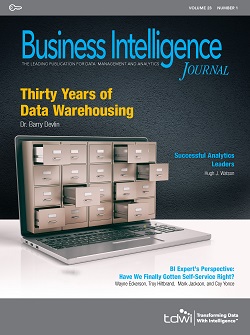
Business Intelligence Journal | Vol 23, No 1
TDWI Member Exclusive
June 11, 2018
Best seller lists have long been populated by business books explaining how to be a better leader or how to get things done. In this issue of the Business Intelligence Journal, we look at the characteristics of a good analytics leader and the new technologies these leaders must understand so users can be more efficient and enterprises can achieve more.
Senior editor Hugh Watson takes an in-depth look at what makes a successful analytics leader. After reviewing current literature—and with the help of three business analytics experts—Watson explains what responsibilities analytics leaders share, examines what differentiates successful analytics leaders from unsuccessful ones, and discusses the challenges in their future. He also explores how analytics leadership changes with analytics maturity.
Leaders must, of course, keep up with the latest technology in their field. Dr. Barry Devlin traces the early history and drivers of data warehousing, then explores one hot technology in particular: data lakes. He explores how data lakes fit with the legacy data warehouse architecture and proposes a new production analytics platform that ties together data lakes and data warehouses. He explains how this platform can extend the data warehouse architecture’s value for another decade.
It’s not enough to understand technology, though. Leaders must also focus on getting work done. Given the increasing volume and complexity of data and the “increasing hunger for data,” Tomer Shiran proposes a new tier in an enterprise’s data infrastructure he calls a data fabric, which provides a self-service model for business users to work efficiently. Self-service is also the subject of our BI experts column. Wayne Eckerson, Troy Hiltbrand, Mark Jackson, and Coy Yonce assess what’s driving interest (and inhibiting adoption) of the technology, offer best practices and gotchas, and discuss the role of leaders in self-service BI.
Another key technology, mobile BI, also puts powerful information into users’ hands, but Kaan Turnali argues that what’s needed is a mobile BI strategy that aligns with an enterprise’s mobility structure. After all, enterprises must go beyond eye-catching reports and colorful tables if they’re to be successful. Turnali offers 10 key areas to consider when developing a comprehensive enterprise mobile BI strategy.
In BI StatShots, our survey results offer best practices to help you lead the way to introducing new analytics into your organization.
As always, we look forward to your feedback; contact us at [email protected].
James E. Powell
Editorial Director
Business Intelligence Journal
IN THIS ISSUE
- Successful Analytics Leaders
Hugh J. Watson
- Thirty Years of Data Warehousing
Dr. Barry Devlin
- A New Logical Tier for Data Analytics: The Data Fabric
Tomer Shiran
- BI Expert’s Perspective: Have We Finally Gotten Self-Service Right?
Wayne Eckerson, Troy Hiltbrand, Mark Jackson, and Coy Yonce
- The Enterprise Mobile Business Intelligence Framework
Kaan Turnali